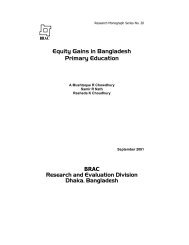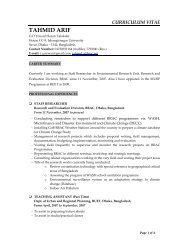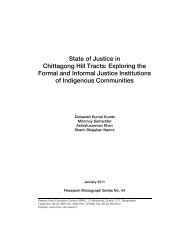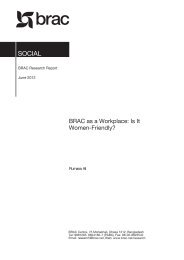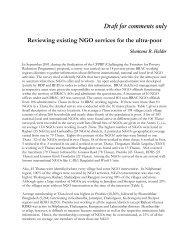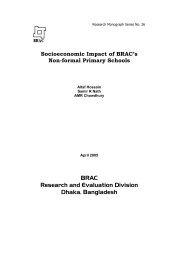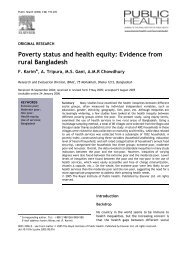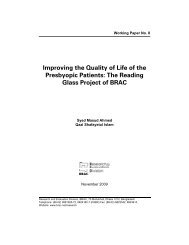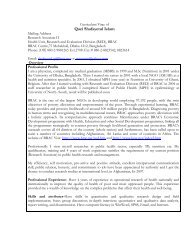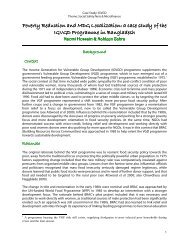Combining health and social protection measures to reach the ultra ...
Combining health and social protection measures to reach the ultra ...
Combining health and social protection measures to reach the ultra ...
You also want an ePaper? Increase the reach of your titles
YUMPU automatically turns print PDFs into web optimized ePapers that Google loves.
Innovation<br />
be adapted – <strong>and</strong> harnessed – <strong>to</strong> a nation’s advantage. In <strong>the</strong><br />
increasingly interconnected global network of science <strong>and</strong><br />
innovation better IP management at <strong>the</strong> institutional level<br />
enables earlier <strong>and</strong> easier access <strong>to</strong> indispensable emerging<br />
<strong>to</strong>ols, technologies, <strong>and</strong> know-how.<br />
Better IP management can be achieved through capacitybuilding<br />
efforts. And <strong>the</strong>se can be sustained through sound<br />
national <strong>and</strong> institutional IP policies. Specific initiatives at <strong>the</strong><br />
institutional level should include capabilities for negotiating<br />
contracts, streamlining statu<strong>to</strong>ry <strong>protection</strong> (copyright,<br />
patents, trademarks, <strong>and</strong> dealing with confidential<br />
information), patent searching <strong>and</strong> filing, freedom <strong>to</strong> operate<br />
reviews <strong>and</strong> strategy (a particular challenge for public sec<strong>to</strong>r<br />
institutions) 5 , technology valuation, <strong>and</strong> business strategy<br />
development. Governments should be cautious, however, not<br />
<strong>to</strong> develop policies that m<strong>and</strong>ate public research institutions<br />
<strong>and</strong> universities <strong>to</strong> adopt a single approach. IP management<br />
is very context specific, <strong>and</strong> flexibility is a precondition for its<br />
creative <strong>and</strong> successful use.<br />
Fur<strong>the</strong>r, <strong>the</strong> increasingly ubiqui<strong>to</strong>us PDP works by building<br />
on <strong>the</strong> comparative advantage of public <strong>and</strong> private sec<strong>to</strong>rs<br />
<strong>and</strong> managing that interface authoritatively. Any institution<br />
that wishes <strong>to</strong> participate needs, at a minimum, <strong>to</strong> be in a<br />
position <strong>to</strong> negotiate complex contracts, manage newly<br />
generated intellectual property, <strong>and</strong> respect third party<br />
intellectual property. This requires mastery of a range of<br />
specifics, from labora<strong>to</strong>ry notebook policies <strong>to</strong> good practices<br />
in managing confidential information <strong>to</strong> name but two.<br />
Since <strong>the</strong> mission of many public institutions is increasingly<br />
shifting from purely academic research <strong>to</strong> making a <strong>social</strong><br />
<strong>and</strong> economic impact at <strong>the</strong> local <strong>and</strong> national level, IP<br />
management is an even stronger imperative. It is an integral<br />
part of a public sec<strong>to</strong>r’s <strong>to</strong>olbox that allows it <strong>to</strong> meet its entire<br />
mission more effectively <strong>to</strong> create hi<strong>the</strong>r<strong>to</strong> unsuspected<br />
opportunities.<br />
One such opportunity lies in <strong>the</strong> manner in which drug <strong>and</strong><br />
vaccine development is changing shape in developed<br />
countries. The blockbuster-focused business model of<br />
multinational pharmaceutical companies is fundamentally<br />
being reshaped 6 . The drivers for this change are complex but<br />
due in part <strong>to</strong> emerging opportunities offered from novel<br />
technologies (diagnostics for personalized medicine, gene<br />
<strong>the</strong>rapies, <strong>and</strong> so forth). As a result, a new range of mergers<br />
<strong>and</strong> acquisitions are taking place. In due course, an entirely<br />
new array of alliances will be created <strong>to</strong> fur<strong>the</strong>r multinationals’<br />
quest <strong>to</strong> create niche remedies that target much smaller<br />
populations than blockbusters did in <strong>the</strong> past. Conceptually,<br />
<strong>the</strong>re is nothing that st<strong>and</strong>s in <strong>the</strong> way for a multitude of<br />
developing country institutions, including public sec<strong>to</strong>r ones,<br />
<strong>to</strong> participate in this new business model <strong>and</strong> concurrently<br />
gain advantage in serving <strong>the</strong>ir own local national niche<br />
markets. But it will require some institutional changes.<br />
Institutional culture <strong>and</strong> individual mindset<br />
To harness <strong>the</strong> power of IP, management capacity <strong>and</strong> skills<br />
are fundamental. Such skills make it possible <strong>to</strong> get earlier<br />
access <strong>to</strong> emerging <strong>to</strong>ols, technologies, <strong>and</strong> resources that<br />
can dramatically improve <strong>the</strong> <strong>health</strong> <strong>and</strong> welfare of <strong>the</strong>ir<br />
citizens. For example, <strong>the</strong> private sec<strong>to</strong>r in India has taken<br />
quick advantage of TRIPS by a) channelling its resources in<strong>to</strong><br />
<strong>the</strong> research <strong>and</strong> development of drugs for diseases that<br />
dominate in developing countries <strong>and</strong> b) building IP<br />
management capacity well before <strong>the</strong> entry in<strong>to</strong> force of<br />
TRIPS 7 . This dual approach provided many companies in<br />
India with substantial foreign investments <strong>and</strong> access <strong>to</strong><br />
foreign markets. In fact, more drug approvals are being<br />
submitted <strong>to</strong> <strong>the</strong> US Food <strong>and</strong> Drug Administration (FDA)<br />
from India than from all o<strong>the</strong>r foreign companies combined.<br />
Similarly, effective IP management can also be made <strong>to</strong><br />
benefit public research institutions. Without knowledge of<br />
sophisticated IP management techniques, however, such<br />
efforts <strong>to</strong> enter in<strong>to</strong> effective public-private partnerships that<br />
can direct <strong>the</strong> power of industry <strong>to</strong> <strong>the</strong> needs of <strong>the</strong> poor will<br />
be stymied.<br />
As previously mentioned, innovation in <strong>health</strong> relies on<br />
sophisticated, global IP rights systems <strong>and</strong> on science that is<br />
increasingly complex, specialized, <strong>and</strong> globalized. This<br />
complexity requires a more open system of knowledge<br />
sharing than previous research <strong>and</strong> development<br />
programmes, <strong>and</strong> many studies suggest that successful<br />
innovation requires developing clusters of institutions,<br />
businesses, <strong>and</strong> personnel. “Location, location, location,” <strong>the</strong><br />
battle cry for real estate agents everywhere, is increasingly<br />
becoming <strong>the</strong> key word in studies of innovation dynamics <strong>and</strong><br />
knowledge-based growth. Prime locations in R&D are referred<br />
<strong>to</strong> as “clusters” – groups of similar-minded institutions <strong>and</strong><br />
individuals who grow <strong>to</strong>ge<strong>the</strong>r. Although companies <strong>and</strong><br />
various not-for-profit entities in <strong>the</strong> same sec<strong>to</strong>r or product<br />
market have traditionally located <strong>the</strong>mselves in specific<br />
geographic regions (ra<strong>the</strong>r than spreading out evenly across a<br />
country), <strong>the</strong> deliberate search for ways <strong>to</strong> encourage<br />
clustering has only recently begun. Institutions have much <strong>to</strong><br />
gain from being located in clusters or strongly linked with<br />
<strong>the</strong>m. Indeed, this strategy is one of <strong>the</strong> most effective ways<br />
<strong>to</strong> bring about institutional change <strong>and</strong> attract entrepreneurs.<br />
Governments have an important role <strong>to</strong> play in <strong>the</strong> process<br />
of cluster formation. In order <strong>to</strong> create clusters, governments<br />
could usefully redirect some of <strong>the</strong>ir funds from bricks <strong>and</strong><br />
mortar <strong>and</strong> product investments <strong>to</strong>wards soft investments in<br />
institutions <strong>and</strong> platforms that create collaborations. Local<br />
<strong>and</strong> national governments can also foster cluster formation<br />
by, for example, offering tax incentives <strong>to</strong> companies <strong>to</strong> set-up<br />
<strong>the</strong>ir operations within a defined zone of geographical<br />
proximity. It is universities, however, that have <strong>the</strong> power <strong>to</strong><br />
lead <strong>the</strong> way in supporting productive research networks.<br />
These networks have <strong>the</strong> potential not only <strong>to</strong> generate new<br />
knowledge but also <strong>the</strong> ability <strong>to</strong> bring in <strong>and</strong> adapt global<br />
knowledge <strong>to</strong> local needs. Indeed, research collaborations are<br />
important both for a university’s academic status <strong>and</strong> for <strong>the</strong><br />
commercial <strong>and</strong> economic prospects of a research-based<br />
cluster. Universities should strive, <strong>the</strong>refore, <strong>to</strong> encourage <strong>and</strong><br />
support research that engages with <strong>the</strong> larger community.<br />
Putting <strong>the</strong> power of intellectual property <strong>to</strong><br />
work for <strong>the</strong> poor<br />
As mentioned, when it comes <strong>to</strong> combating diseases <strong>and</strong><br />
086 ✜ Global Forum Update on Research for Health Volume 4



